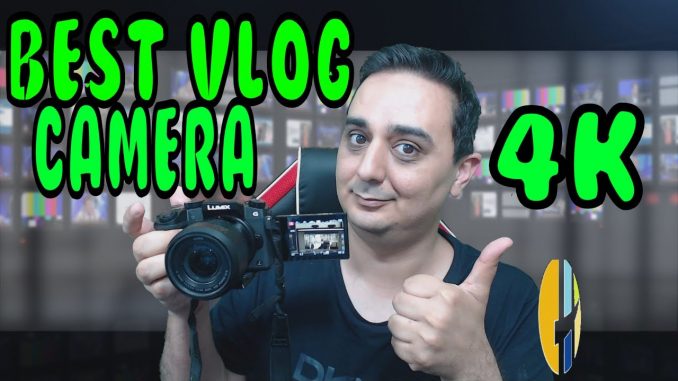
Best 4K VLOG Camera – Panasonic Lumix G7 4K Camera
Best 4K VLOG Camera – Panasonic Lumix G7 4K Camera Kodi:
Purchase and information goo.gl/249dyV
My best 4K Vlog Camera. This camera replaces my previous Nikon Camera which I use to use on a daily base. But my Nikon I had so much trouble trying to focus so it needed much work taken pictures and videos.
With this camera I do most of new videos now with it.
And it is just wonderful.
Specially when I try to review products and do Family Photos
Used it Already for weddings and for Trips and special events.
Purchase and information goo.gl/249dyV
The Lumix G7 may be the first 4K camera you consider that makes you plan a vacation just to use its features. At about a pound and the size of a pregnant smartphone, it's one of the most capable budget cameras we've reviewed.
If you don't want to lug your Blackmagic Cinema Camera to shoot video on your next trip to the coast with the kids and dogs and you'd like to get some great stills too, take a close look at the Lumix G7. It’s small, lightweight, costs less than $800 and fits perfectly in that middle ground between your main camera and your smartphone. In fact, to be fair, the image quality and features make it come a lot closer to your main rig than you might expect.
The Lumix G7 features a micro four thirds 16-megapixel MOS sensor powered by the Venus Engine 9 processor built into an interchangeable lens camera package that fits nicely in your hands. The design is a bit retro, sporting large mode dials on the top but with direct access to many programmable function buttons, control dials, cursors and high resolution live viewfinder and articulating monitor, there is nothing old fashioned about the Lumix G7.
For video, it takes a small crop from the center portion of the sensor then scales down to 4K, HD or VGA formats that give you a 2x crop factor. One of the most exciting developments of current cameras is increasingly capable autofocus in movie mode and the Lumix G7 features powerful and usable AF options for videographers.
Direct Control
Most of us like having as much direct control as possible over our camera's main functions such as aperture, shutter speed, ISO and exposure compensation. While the Lumix G7 excels in providing very intelligent fully automatic modes, the basics are only a fingertip away. In fully manual mode, the front dial controls the aperture, the rear dial the shutter speed and function buttons one and three control exposure compensation and ISO respectively.
While the Lumix G7 excels in providing very intelligent fully automatic modes, the basics are only a fingertip away.
The Lumix G7 gives you additional direct control of dozens of features with six assignable function buttons on the camera body and another five nested in a pop out window on the right side of the touch screen. Depress the Disp button a few times and you'll have all the key camera operations at your fingertips. Touching on Fn launches an intuitive drawing of the camera and all the assignable function buttons letting you program each with most of the camera's features. Yes, you are still digging a few levels down to make things happen, but Panasonic has made this process as intuitive as possible, even providing a description crawl at the top of the screen which is painfully slow but still helpful.
The layout on the top includes the on/off switch, drive and shooting mode dials, front and rear control dials, function buttons one and six, a stereo microphone and the movie record button. This record button is a bit too small and lacks enough travel when you press it, making it hard to know if you really started recording by feel alone. We liked the placement of the stereo mic on top of the hot shoe as it reduces the chance of your fingers accidentally covering the inputs.
Controls on the back of the Lumix G7 are well laid out and easy to reach with your thumbs. At the top is function button five, the flash release, the LVF diopter adjustment wheel and the AF/AE lock button surrounded by the AF type selection lever. The layout on the right side of the back include function buttons two, three and four, playback, display and menu buttons, four cursor controls and the small speaker.
The Lumix G7's connections for wired remote control, HDMI and AV/Digital outputs are on the right and the mic jack is on the left side placed above where the articulating monitor can swing out. With no cable locking accessory, you'll need to be careful when moving the monitor. The only thing missing to make the Lumix G7 a full-featured video camera is a headphone jack for monitoring audio. The battery and SD card slips into the bottom of the Lumix G7. It is a minor annoyance, but the door does not self lock; you have to slide the locking switch back into place unlike what we find on most other camera models.
Quality 4K and More
We used the Standard photo style for most of our tests and recorded clips in each resolution of the MP4 and AVCHD formats. The 4K image quality is very good but a bit contrasty. It was easy, however, to add an in-camera Highlight/Shadow adjustment curve, use the Intelligent Dynamic setting or add the High Dynamic filter to greatly improve the detail in both the light and dark areas.
The color, sharpness and resolution of the 1920 x 1080, 1280 x 720 and 640 x 480 files in both types looked very good for their respective resolutions but also a bit contrasty without adjustment. We noticed some color banding in gradients that is usual with color sample ratios of 4:2:0 in 8-bit. Auto white balance worked very well even in mixed light conditions except skin tones seemed a bit too saturated. We could not see any strong moiré patterns when shooting horizontal lines. The leaning effects of rolling shutter are moderately evident when quickly panning. Overall, we were impressed with how good the daylight video looked for a sub-$1000 camera.
Auto Focus for Real
The G7 has four AF types: Single, Flexible, Continuous and Manual along with six modes; Face/Eye Detection,Tracking,49-Area, Custom Multi, 1-Area and Pinpoint. The G7 focus uses contrast rather than phase detection but Panasonic improves the responsiveness and accuracy with their Depth-from-Defocus technology that senses changing distances from the subject. It still may not be quite as quick or accurate as phase detection found in more expensive cameras, but it works surprisingly well under bright conditions. It will slow and hunt a little as light dims. To help us out in low light, we liked the ability to manually touch up focus after using the AF.
4K Photo Power
Yes, the Lumix G7 takes great photos, too. In fact, the additional photo-specific features packed into this small package almost make you forget it shoots 4K video. You'll not only find amazing built-in HDR, intelligent scene detection, 4K photo extraction and face/eye detection but also an incredible Face Recognition ability that lets you register a face and the G7 will automatically focus on that face for future photos complete with naming the subject in metadata, even noting their age if you plugged in their birth date.
Panasonic highlights the G7's 4K Photo modes and yes, it is pretty cool for capturing the perfect action shot. It certainly gives new meaning to the term, “run and gun.” There are three modes; 4K Burst, Burst Start/Stop and Pre-Burst. With 4K burst you hold the shutter button down for the length of your shot. This mimics the way traditional still cameras operate, complete with a rather cheesy sound of a mechanical shutter. The Burst Start/Stop starts when you first press the shutter button then stops when you hit it again sans sound effects. The 4K Pre-Burst records a second before and after you hit the shutter button. The method for reviewing the potentially large number of images is very intuitive. You simply use the cursor buttons to scroll a set of 60 frames at a time and when you find the one you like, you select and save as an 8 megapixel photo. The photos we grabbed from our test footage showed a little noise in the darks, but the overall images looked quite good. But remember these are essentially 4K video frame grabs and the full 16 megapixel stills have more image quality.
Other Cool Features
The smartphone/tablet Wi-Fi control option is very useful, especially if you want to avoid touching the monitor when controlling focus — or power zoom with capable lenses. It does require either an iPhone or Android with a relatively current OS and you have to download the Panasonic Image App. Once installed the G7/smartphone connection sync is easy and we were remotely controlling our G7 in just a few minutes. Other reviewers have noted the process can be buggy or complex, but this was not our experience. The smartphone image lags the G7 monitor a little, but unless you are watching both at the same time, you probably won't notice.
The Lumix G7 includes an automated diffraction compensation setting that attempts to counteract the image softening that happens with small apertures. While it applies to movie mode we could not detect any improvement in sharpness shooting at f22.
Snap Movie lets you quickly shoot a short 1920 x 1080 MP4 clip between two and eight seconds. You can easily transfer these clip via Wi-Fi to a Smartphone or tablet for sharing online. The G7 comes bundled with basic video editing software called PHOTOfunSTUDIO and Silkypix, a RAW photo editor. PHOTOfunSTUDIO is very basic, guiding you from transferring images to your hard drive to simple clip joining or “retouching” that lets you do clip trimming and simple image manipulation. Remember, if you are planning on shooting a lot of 4K, be sure your computer is up to the task.
Conclusion
The Lumix G7 is small, lightweight, powerful and while not perfect, it gives you good 4K video for an incredibly low price. AF is a real asset in most situations but low light video quality is lacking. The Lumix G7 has lots of features which results in lots of menus — perhaps too many particularly if this camera is designed for the casual user. For less than $800, the Lumix G7 is a great camera to take on your next vacation. Plus it's a snap to make your friends envious by instantly sharing your shots.





Be the first to comment